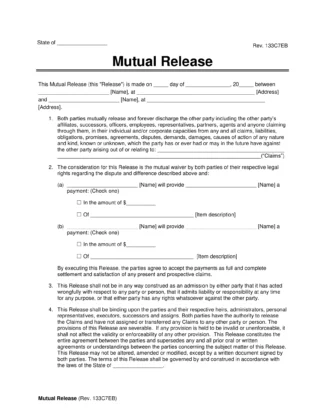
Implement a mutual liability release agreement to discharge all involved parties from future obligations and responsibilities.

Updated February 1, 2024
Written by Yassin Qanbar | Reviewed by Brooke Davis
A mutual release of liability (waiver) form is a legal document used to absolve all parties in an agreement from legal liability for any claims arising from a specific transaction or occurrence. It’s commonly used in situations where two parties are settling a dispute or severing a relationship and want to avoid future claims.
A mutual release agreement can help the involved parties acknowledge responsibilities and achieve a solution to a legal problem or dispute without getting involved in a lengthy, expensive legal process.
It may be used in situations such as:
Both types of releases are legally binding and require valuable consideration to ensure they comply with relevant laws and fully protect the interests of all parties involved.
Your mutual release of liability should include details regarding the parties involved and the matter being addressed. Begin with a fillable mutual release agreement that covers all your legal requirements. Then, enter the following details.
Enter the state where the agreement applies. For example, if you are settling a business dispute in Maine, complete the agreement for Maine, even if you complete the form in a different location.
Add the full day, month, and year you complete the mutual release form. This is the date the agreement goes into effect.
Enter the full names and addresses of participants in the mutual release. If either party represents a business, enter the business name and address as well as the representative’s name.
Explain the matter that the mutual release addresses. Include as much detail as possible.
Explain how the matter will be resolved. This is typically through financial payment or exchange of a disputed item. Indicate who will pay the consideration, who will receive it, and the amount of money or a specific item you will exchange.
Indicate that signing the release is not an admission of fault or responsibility by either party. Both parties agree that neither party owes the other anything beyond the exchange specified in this release.
Clearly outline the scope of the release of liability. Declare which risks, liabilities, damages, and other claims are released by this agreement. Include terms for alterations, amendments, transferability, and enforceability. This section indicates which state’s laws apply to the mutual release.
All parties should print their names, sign, and date the agreement. Depending on the state where you sign the release, you may need a notary or witnesses. Check your state laws before signing.
Avoid signing the contract until you review your state’s notarization requirements. Failure to meet legal signature guidelines could invalidate your mutual liability release.
To fully execute a valid mutual release liability form, you may need signatures from multiple witnesses. You may also need a notary acknowledgment form. Every state’s requirements differ.
For example, New York does not require notarization for release of liability, per NY. Gen. Oblig. Law § 15-303 . Mississippi, on the other hand, requires certain liability waivers to be notarized.
States also have different guidelines for storing and sharing a mutual liability waiver. To cover your bases, consider storing both electronic and secure copies in a physical location. Maintain your privacy by submitting documents through encrypted programs designed to ensure confidentiality.
Your waiver’s enforceability will often depend on clear and specific language. To protect yourself, consider the following:
In the event of a misunderstanding or dispute, you may have to pursue legal action. Consult with an attorney familiar with contract laws in your state before you proceed to understand.
Download a mutual release of liability form in PDF or Word format.